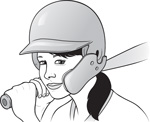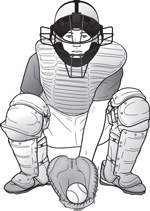
Baseball Injury Prevention
The U.S. Consumer Products Safety Commission reports that in 2010 more than 414,000 Americans were treated in hospitals, doctors' offices, and hospital emergency rooms, for baseball-related injuries. More than 282,000 of the players treated were 18 years old or younger.
Common Baseball InjuriesThe most common baseball injuries include mild soft tissue injuries, such as muscle pulls (strains), ligament injuries (sprains), cuts, and contusions (bruises).
Although baseball is a non-contact sport, most serious injuries are due to contact — either with a ball, bat, or another player.
The repetitive nature of the sport can also cause overuse injuries to the shoulder and elbow.
Proper Preparation for PlayFor Coaches
- First aid. Familiarity with first aid, including recognizing and treating the most common injuries, is especially important for coaches. Be able to administer basic first aid for minor injuries, such as facial cuts, bruises, strains, sprains, and tendonitis.
- Field knowledge. Be familiar with your baseball field, including its telephone and cardiac defibrillator.
- Emergency situations. Be prepared for emergencies. Have a plan to reach medical personnel for help with more significant injuries like concussions, breathing problems like wheezing, heat illness, and orthopaedic emergencies, such as fractures and dislocations.
- Follow the rules. Know the rules and encourage safe and appropriate play.
For Players
- Physical exam. A pre-season physical exam is important for both younger and older players. The goal is to prevent injuries and illnesses by identifying any potential medical problems. These may include asthma, allergies, heart, or orthopaedic conditions.
- Warm up and stretch. Always take time to warm up and stretch.
Warm up with some easy calisthenics, such as jumping jacks. Continue with walking or light running, such as running the bases.
Gentle stretching, in particular your back, hamstrings, and shoulders, can be helpful. Your team coach or athletic trainer may provide a stretching program.
 Batting helmet with face shield
Batting helmet with face shield
- Equipment should fit properly and be worn correctly.
- Wear a batting helmet at the plate, in the "on deck" circle waiting your turn at bat, and during base running.
- Protective face shields attached to batting helmets can reduce the risk of facial injury if hit by a ball.
- Position-specific equipment should be used.
- Catchers should always use a catcher's mitt, helmet, face mask, throat guard, long-model chest protector, protective supporter, and shin guards.
- Batters should consider wearing protective jackets to avoid injury from being hit by ball.
- Wear molded baseball shoes that fit properly and have appropriate cleats.
- Gender-specific equipment may be of value, including athletic supports for boys/men and padded bras for girls/women.
- In youth leagues, softer baseballs decrease the risk of injury from being hit by a pitched ball.
- Players should be instructed in how to avoid getting hit by a ball.
 Catcher's protective gear
Catcher's protective gear
- Inspect the playing field for uneven terrain (holes, divots), glass, and other debris.
- Use a field with breakaway bases. Many injuries occur while sliding into bases. The traditional stationary base is a rigid obstacle for an athlete to encounter while sliding. In contrast, a breakaway base is snapped onto grommets attached to an anchored rubber mat, which holds it in place during normal play. Although a sliding runner can dislodge it, the breakaway base is stable and will not detach during normal base running. Installing breakaway bases on all playing fields could significantly decrease sliding injuries.
- Assess weather conditions and be prepared to delay/cancel the game, especially in cases of particularly hot weather or thunderstorms with lightning.
Base Running
The American Academy of Orthopaedic Surgeons recommends the following tips for those individuals sliding into, as well as protecting, the bases while playing baseball and softball:
- Players under age 10 should not be taught to slide.
- Proper instruction in sliding technique must be taught and practiced before using any bag, including the breakaway bases. Practice should first be with a sliding bag.
- The "obstruction" rule must be taught and observed. Getting in the way of the runner or blocking the base without possession of the ball is dangerous to both the runner and fielder.
- When coming into home plate, it is important that the runner attempt to slide to avoid a collision.
- To prevent ankle and foot injuries between the runner and fielder at first base, a "double bag" — a separate bag for both the runner and first baseman — should be used.
Pitching and Throwing
Follow established guidelines for youth baseball, which include limiting the number of pitches thrown and type of pitches thrown, according to age. The following guidelines are recommended by the USA Baseball Medical & Safety Advisory Committee.
- Pitch Count Limits:
| Age | Max. Pitches/Game |
Max. Pitches/Week |
|---|---|---|
| 8 - 10 | 50 | 75 |
| 11 - 12 | 75 | 100 |
| 13 - 14 | 75 | 125 |
| 15 - 16 | 90 | 2 games / week |
| 17 - 18 | 105 | 2 games / week |
- Ages for learning types of pitches:
| Fastball | 8 |
| Change-up | 10 |
| Curveball | 14 |
| Knuckleball | 15 |
| Slider | 16 |
| Forkball | 16 |
| Splitter | 16 |
| Screwball | 17 |
Both coaches and parents should be responsive to young pitchers who complain of arm or shoulder pain. Be sure to seek out medical care for arm pain that does not go away or that comes back every time a child resumes pitching.
Prevent Overuse InjuriesBecause many young athletes are focusing on just one sport and are training year-round, doctors are seeing an increase in overuse injuries. The American Academy of Orthopaedic Surgeons has partnered with STOP Sports Injuries to help educate parents, coaches, and athletes about how to prevent overuse injuries. Specific tips to prevent overuse injuries in baseball include:
- Limit the number of teams in which your child is playing in one season. Kids who play on more than one team are especially at risk for overuse injuries.
- Do not allow your child to play one sport year round — taking regular breaks and playing other sports is essential to skill development and injury prevention.
- Do not allow your child to pitch on consecutive days and avoid pitching on multiple teams with overlapping seasons.
Good communication between doctors, players, parents, and coaches is key to diagnosing and treating more significant baseball injuries.
Young players may not be able to recall exactly how an injury happened or describe their symptoms in detail. They may even hide injuries because of concern about being removed from play.
Coaches and parents must pay close attention to changes in a player's participation or performance. Should there be an injury, doctors may need their help to provide accurate details and a medical history.
Safe Return to PlayAn injured player's symptoms must be completely gone before returning to play. For example:
- In case of a joint problem, the player must have no pain, no swelling, full range of motion, and normal strength.
- In case of concussion, the player must have no symptoms at rest or with exercise, and should be cleared by the appropriate medical provider.
- In case of a shoulder or elbow overuse injury, the player should gradually return to a throwing program, increasing the number of throws depending on the length of time away from play, and their specific team position.
Source: http://orthoinfo.aaos.org/topic.cfm?topic=A00185
